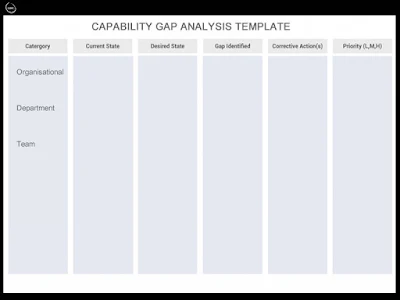· Capability is a combination of skills, knowledge, resources, and processes that enable an organization to perform a specific function or achieve a specific outcome.
· Capability maps are hierarchical diagrams that show the relationships between the different capabilities of an organization.
For example, a capability map for a retail
company might include capabilities such as:
·
customer service,
·
inventory management,
·
marketing, sales, and
·
logistics.
Each capability can be further decomposed into
sub-capabilities that provide more detail and granularity. For example,
customer service might include sub-capabilities such as:
·
feedback,
·
complaints,
·
loyalty programs, and
·
refunds.
Capability gap analysis is derived by checking these capability maps and looking for the places where rectifications are required to meet the business goals. The revamping of the existing capabilities concerning the desired capabilities is the crux of undertaking capability gap analysis.
1. Visualizing Strengths and Weaknesses: Capability maps provide a clear picture of our current skills and resources across departments and locations. By pinpointing areas where capabilities overlap or fall short, we can easily identify gaps in talent, knowledge, or processes.
2. Benchmarking against Goals: Capability maps allow us to compare our existing capabilities to our strategic goals and objectives.
This helps us pinpoint areas where we need to
upskill our workforce, acquire new technology, or refine our business processes
to bridge the gap and achieve our desired outcomes.
3. Facilitating Informed Decision-Making: With capability maps, we can make data-driven decisions about talent development, resource allocation, and strategic partnerships.
By understanding our capability strengths and weaknesses, we can invest in targeted training programs, attract talent with specific skill sets, or outsource tasks where we lack internal expertise.
4. Identifying Market Opportunities: Capability maps can also reveal gaps in the broader market.
By analyzing our capabilities alongside
customer needs and industry trends, we can identify potential new markets or
service offerings where our unique capabilities can provide a competitive
advantage.
Overall, capability maps are a powerful tool
for identifying gaps within our organization and taking strategic action to
address them. By continuously monitoring and updating our capability maps, we
can ensure our company remains agile, competitive, and well-positioned for
future success.




